
Christgarten Charterhouse (German : Kloster Christgarten) is a former Carthusian monastery, or charterhouse, near Ederheim in Bavaria, Germany.

Christgarten Charterhouse (German : Kloster Christgarten) is a former Carthusian monastery, or charterhouse, near Ederheim in Bavaria, Germany.
The monastery, dedicated to Saint Peter, was founded in 1383 by Counts Ludwig and Friedrich von Oettingen. From 1525 the counts of Oettingen supported the Reformation, and from 1558 Carthusian monks from Christgarten were called to be Protestant ministers. In the course of the Reformation the prior of Hürnheim (near Ederheim) also converted to the new teaching and from then on ministered to Christgarten in a Reformist spirit.
Nevertheless, the charterhouse was not dissolved until after the Thirty Years' War, in 1649. In 1656 the bell tower was demolished; further buildings followed in the 18th and 19th centuries. All that remained of the monastic church was the choir, which was used as the Protestant parish church. The "Scheuffelin altar" was given to the Alte Pinakothek in Munich.

Blaubeuren Abbey was a Benedictine monastery until the Reformation, located in Blaubeuren, Baden-Württemberg, Germany. It is now a Protestant seminary.
Buxheim Charterhouse was formerly a monastery of the Carthusians and is now a monastery of the Salesians. It is situated in Buxheim near Memmingen in Bavaria.
Roggenburg Abbey is a Premonstratensian canonry in Roggenburg near Neu-Ulm, Bavaria, in operation between 1126 and 1802, and again from its re-foundation in 1986. Since 1992 it has been a dependent priory of Windberg Abbey in Lower Bavaria. The monastery manages a training centre and a museum, and is widely known for its almost unchanged Baroque building and the organ concerts that are held in the church.
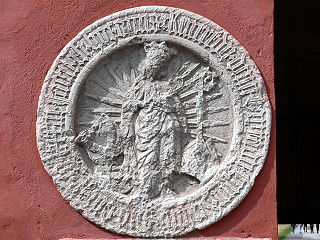
Mariefred Charterhouse, sometimes referred to as Gripsholm Charterhouse, was a Carthusian monastery, or charterhouse, in the present town of Mariefred in Södermanland, Sweden, to which it gave its name; before the building of the monastery the place was known as Gripsholm. It was the only Carthusian monastery in Scandinavia, and one of the last monasteries established in Sweden before the Reformation.
Eppenberg Charterhouse was a charterhouse, or Carthusian monastery, now a ruin, situated on the Eppenberg next to the Heiligenberg in Gensungen, now part of Felsberg in Hesse, Germany. It was established to replace a failing monastery of Premonstratensian canonesses.
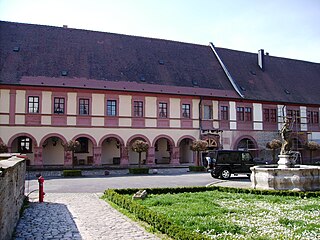
Tückelhausen Charterhouse is a former Carthusian monastery, or charterhouse, in Ochsenfurt in Bavaria, Germany.

Prüll Charterhouse, previously Prüll Abbey, is a former Carthusian monastery, or charterhouse, in Regensburg in Bavaria, Germany.
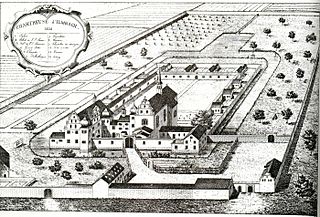
Ilmbach Charterhouse, also Mariengarten Charterhouse, is a former Carthusian monastery, or charterhouse, in Prichsenstadt in Bavaria, Germany.

Grünau Charterhouse is a former Carthusian monastery, or charterhouse, in Schollbrunn in Bavaria, Germany. It was the first Carthusian monastery in Franconia and in today's Bavaria.

Astheim Charterhouse, also known as Marienbrück Charterhouse, was a Carthusian monastery, or charterhouse, in Astheim near Volkach in Kitzingen, Bavaria, Germany.
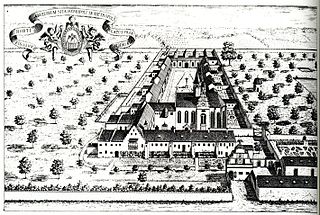
Engelgarten Charterhouse or Würzburg Charterhouse is a former Carthusian monastery, or charterhouse, in Würzburg in Bavaria, Germany.

Marienau Charterhouse is a Carthusian monastery, or charterhouse, the successor to the Maria Hain Charterhouse in Düsseldorf, located since 1964 in Marienau, a part of Bad Wurzach, district of Ravensburg in Baden-Württemberg. It is the only extant Carthusian monastery in Germany.

Cologne Charterhouse was a Carthusian monastery or charterhouse established in the Severinsviertel district, in the present Altstadt-Süd, of Cologne, Germany. Founded in 1334, the monastery developed into the largest charterhouse in Germany until it was forcibly dissolved in 1794 by the invading French Revolutionary troops. The building complex was then neglected until World War II, when it was mostly destroyed. The present building complex is very largely a post-war reconstruction. Since 1928, the Carthusian church, dedicated to Saint Barbara, has belonged to the Protestant congregation of Cologne.
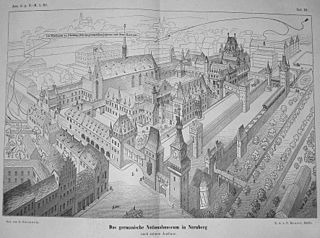
Nuremberg Charterhouse was a Carthusian monastery, or charterhouse, in Nuremberg in Germany. Its surviving premises are now incorporated into the Germanisches Nationalmuseum.
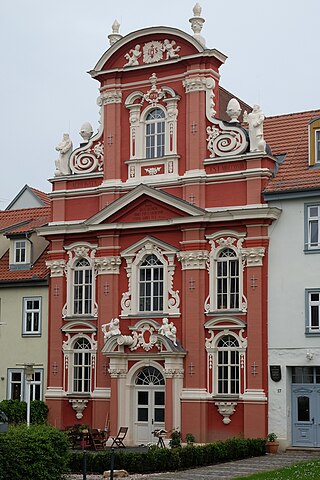
Erfurt Charterhouse is a former charterhouse, or Carthusian monastery, in Erfurt, Thuringia, Germany. It was founded in the 1370s: building works began in 1372 and the monastery was accepted into the Carthusian Order in 1374. Work started on the church in 1375.

Vogelsang Charterhouse was a Carthusian monastery or charterhouse near Jülich in the present North Rhine-Westphalia, Germany, founded in 1478 and secularised during the mediatisation of Germany in 1802.

Güterstein Charterhouse was a Carthusian monastery in the Swabian Alb near Bad Urach, Baden-Württemberg, Germany.